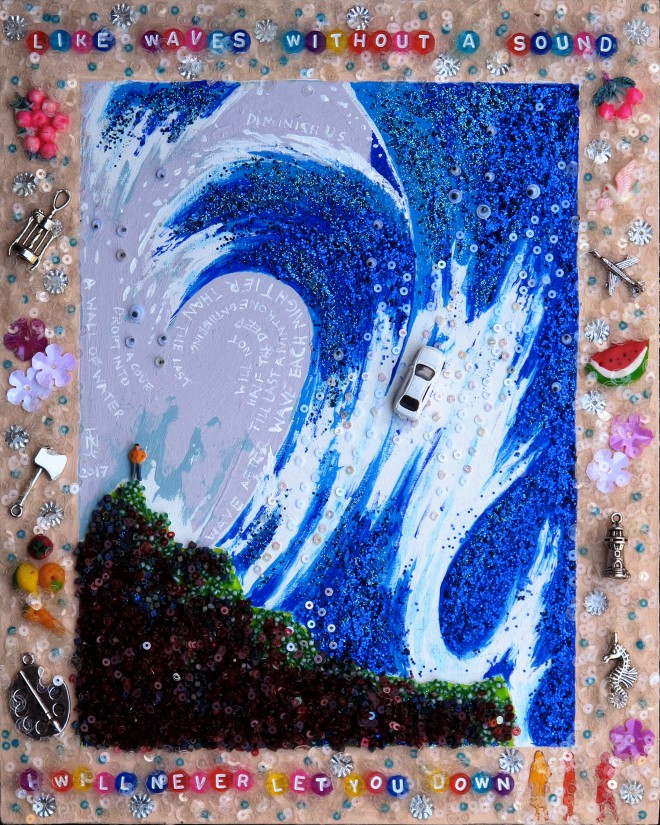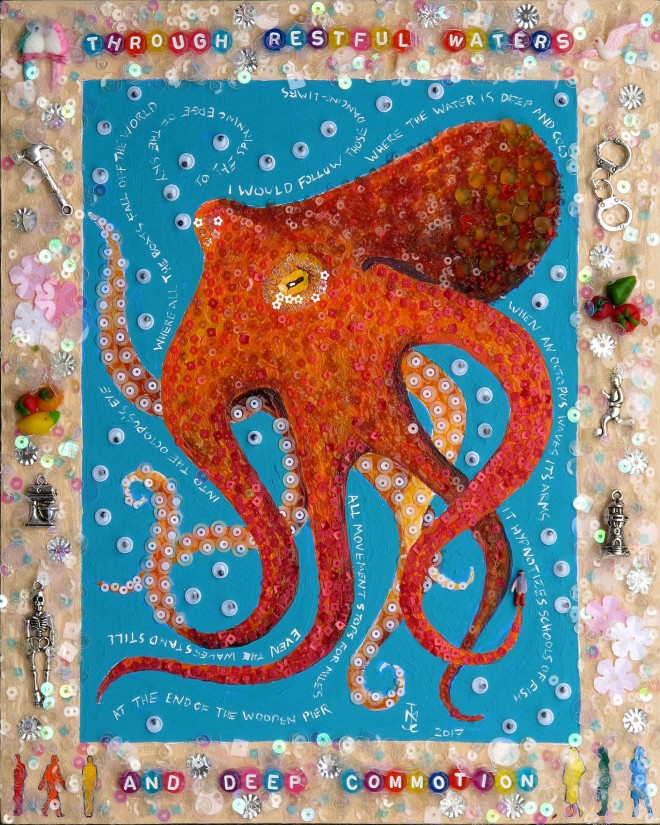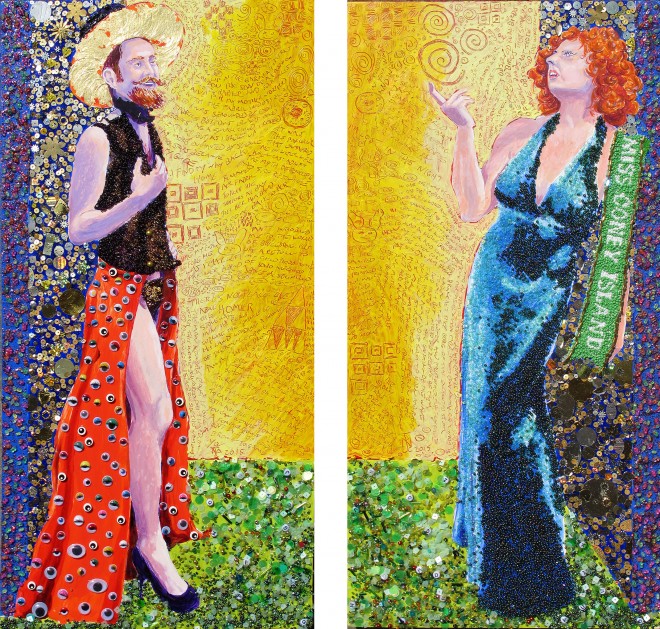Joy, being a post-bear bearded gay man, Greece and copious sequins: Nicholas Moore is adept at bringing great overarching themes of love and identity and intricate techniques to create artistic works that are unmistakably his; dissecting a whole into independent moments of meaning, then bringing them back together into a final finished piece. Having spent much of his life in Crete, Syros and Athens, the Greek influence is consistently evident in his work, with motifs, soft light and poignant splashes of colour pervading early oil paintings which covered landscapes as well as portraits. Although now London-based, Moore worked from Athens before and during peak times of austerity, witnessing and participating in the artistic revival of the city in spite of the economic crises in the country. The last five years have seen a widening of his approach, working with assemblage and sculpture to offer textured portraits of both individuals and pockets of feeling. As he starts planning solo shows this autumn, Twin caught up with him to discuss ByzantoJapanese Pop, celebrating gay and trans culture and perceptions of masculinity in 2017.
Your work focusses on mythology and also on portraits of people, I’m interested in how you perceive the relationship between the two – do you find that the two feed and influence each other?
Mythology has been an obsession with me since childhood and it is the core to a lot of what I do. There are times where I make obvious allusions to various stories and myths and others where it informs the work subconsciously as it has been part of my life for so long. I also have a huge comic book collection dating back to the 30s. These are modern Myths, their continuing success shows us how important such stories are to us.
The figure is an important part of my work however I am hesitant to use the word portraiture as it conjures up a certain type of work that I don’t aspire too. My work is most definitely representative and I’m commissioned to make portraits, however my work is as much interested in portraying, ideas, stories and myths, as much as character and appearance. When I make a portrait of someone, I surround them with objects relating to them and their life. There will be texts, either quotes from favourite songs etc or a stream of conscious memories and associations I have about them. Sometimes in the bigger works I will also have texts directly relating to mythology.
In this context I’m especially interested in how you depict the male body using mythological motifs. Do you feel that perceptions of masculinity have changed in recent times?
These things shift back and forth: just as you think things are all cool and dandy, someone calls you a poof on the streets – I didn’t expect that in 2017 ! Fluid sexuality, gay marriage, tolerance – all these other good things threaten those poor beleaguered straight men, so they fight back. Maybe in Europe and parts of America these perceptions have become more fragmented, and yet each of those fragments have a longer staying power than they once had. There are lots of different tribes in the gay community, I tend to get shunted into the ‘Bear’ community just by virtue of my beard. I am neither particularly fat nor hairy. It’s ridiculous, I’m Post-Bear! I would say the young (and the young at heart) care less about such things.
For your portraits, you often often focus on couples and dualities within one person. What is it about relationships that interests you as a subject?
I think it is more about the contrast between the two that interests me. I don’t paint these couples on the same panel, each individual has his own space, they then play against the other. The Stanley portrait being a good example of that. On one panel is his more serious business side versus his more playful ‘Hedwig’ role. I hosted a talk in a community collage in NYC about this painting. It was amusing to hear the students coming up with all these stories about who they thought he was. A few students got very involved in imagining his troubled life in the corporate world, and how he would find a release cross dressing at night – I hated to break it to them that, he was in fact a very happy guy, a Mexican silver dealer who just had a large sense of fun and a tad provocative. Who’s to say which version is the truth.
In recent years your focus has moved towards assemblage. What was it about the medium that interested you?
I had made small works using that medium in the 80s, but it wasn’t until my show in Athens in 2008 that I really started showing any. I had seen in the Topkapi museum an Ottoman miniature that was stuck on a page with seemingly random images surrounding it. I liked that, to my uneducated eyes, I could see no connection between the images. At the same time I had my first computer and the overlaying windows of different programs always fascinated me – how more and more disparate images were somehow ok within that context: the screen fixing the random images into one whole.
Last year I started to make images that were surrounded by borders that have charms, flowers, alphabet beads, etc. in them. This allows me to join disparate images together as if they were part of one of those cross-stitched samplers children used to make. I can then make larger images, sort of portraits of a person, from lots of seemingly disparate parts. In my series “The Last Lighthouse Keeper” the figure is broken into symbols: a leg is an octopus, an arm is a ray gun, and so on. Our world is not some marvellous minimalist construct but a riot of clashing images sounds and smells.
What are your favourite materials to work with? Do items assume significance once placed within the content of the portrait, or is it because they have significance that you choose them?
I still love working with paint but enjoy combining the different textures of paint, beads, sequins etc., layering different types of colour on top of each other. When I do someone’s portrait I ask them some set questions to get some ideas as to objects I could add, texts I could use, colour. This then governs what materials and objects I choose. In general I am fascinated with the power of objects and the personal history we attach to them. Also the cultural importance objects gain over time.
A previous interview classified your work as ‘Pop art’ – is that a label you feel represents what you do?
I feel ByzantoJapanese Pop is best.
More generally speaking, who and what are you influenced by?
Music, Mythology, Matisse, Sex, Humour, Colour and most of all Joy.
You spent a lot of time in Greece over the years, and that’s very present in your work. How would you describe the art scene in Athens at the moment?
Blossoming in adversity: I love Athens. Like everywhere else it’s hard for artists to survive financially. However it’s cheaper than a lot of places to live and work in, assuming of course you are not trying to live off a Greek income. There is the gallery scene which, though abundant, is again like elsewhere – struggling with sales. There is a huge street art scene and a strong sense of political struggle in a lot of the work.
What’s in store for the rest of 2017?
I was just in an exhibition at the Stash GalleryVout-O-Renee’s to raise funds for survivors of Grenfell fire, which has a strong resonance for me as I lost my Mother in a hotel fire. In September I’ll be showing at the Mykonos Biennale and later in September I’m part of a group show in Amherst Massachusetts America. Then I’ll be focussing on upcoming solo shows in Athens and New York.
Nicholas Moore will be on show at the Mykonos Biennale, from 1st September and at Hampden Gallery, Massachusetts from September 10th.





 PREVIOUS
PREVIOUS

 Twitter
Twitter
 Tumblr
Tumblr
 YouTube
YouTube
 Facebook
Facebook
 Instagram
Instagram
